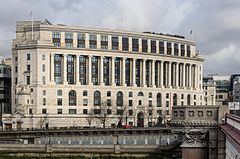Former names Lever House Floor area 385,500ft² | Renovated 1977–83; 2004–07 Opened 1933 Construction started 1929 | |
 | ||
Location BlackfriarsLondon, EC4United Kingdom Completed 1933; 84 years ago (1933) Similar Unilever Research & Develo, Colworth House, Blackfriars Bridge, Lever House, Blackfriars Railway Bridge | ||
Unilever House is a Grade II listed office building in the Neoclassical Art Deco style, located on New Bridge Street, Victoria Embankment in Blackfriars, London. The building has a tall, curving frontage which overlooks Blackfriars Bridge on the north bank of the River Thames.
Contents
Map of Unilever House, London, UK
The site of Unilever House was previously occupied by Bridewell Palace, a residence of Henry VIII, which later became a poorhouse and prison. These buildings were destroyed in 1864 making way for De Keyser's Royal Hotel. In 1920, Lord Leverhulme leased the site to build the London headquarters of his soap manufacturing company Lever Brothers, which became Unilever in 1930. Construction did not commence until 1929.
Construction
The building design and construction is thought to be a collaboration between James Lomax-Simpson, a member of the Unilever Board, and John James Burnet and Thomas S. Tait, partners in the firm of Sir John Burnet and Partners. However, there is some uncertainty over the credit for the design; a note by Simpson claims exclusive credit, suggesting that Burnet and Tait only approved the final design. Burnet and Tait exhibited the design as a joint work with Simpson at the Royal Academy, and the drawings held at the City of London Record Office are signed by Burnet and Tait alone.
John James Burnet, although active in this project, was retiring around this time due to ill health, and Tait, a leading practitioner of modern architecture, worked on aspects of the building design.
The main contractor for the construction of the building was Holland, Hannen & Cubitts.
Architecture
The most striking aspect of the building is its enormous curving frontage along the Victoria Embankment, with its giant Ionic columns between the fourth and sixth floors. The heavily rusticated ground floor is windowless to reduce traffic noise inside the building. The corners are marked by entrances surmounted by large plinths on which are placed sculptures of human figures restraining horses (called Controlled Energy) by Sir William Reid Dick. Merman and mermaid figures are by Gilbert Ledward. The original lift cars were lined with art deco pewter panels designed by Eric Gill.
Renovation
A refurbishment of 1977–83 saw the addition of parapet figures by Nicholas Munro and a new north entrance lobby in a Neo Art Deco style, by Theo Crosby of Pentagram. The building has been extended along Tudor Street.
In 2004, the firm Kohn Pedersen Fox Associates began renovation work in consultation with English Heritage and the City of London to make alterations to the interior work space. As part of the renovations, original fittings were retained or re-used, such as parquet flooring or Eric Gill's pewter lift car panels, but Crosby's distinctive and historically-important additions were removed. A roof garden was created on top of the building.
